Stress and anxiety are common emotions that plague some people more than others, and circumstances, health, our environment and personal mental state can accelerate it. There are a number of ways to deal with anxiety, from exercise and meditation to eating habits and counselling. One of the best ways to deal with and stay on top of stress is through yoga, an ancient exercise that connects the body and mind. The physical asanas (postures) of yoga, mixed with breathing techniques and meditation, can calm the mind, bring perspective and help you deal with anxietal issues for mental clarity and inner peace.
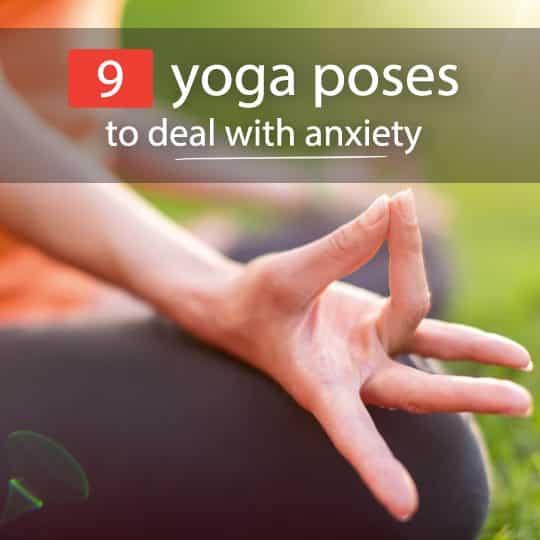
Yoga For Anxiety
Yoga has many benefits beyond lowering stress levels and grounding you. It can be a great exercise for weight loss, as well as improving circulation, increasing flexibility and boosting respiratory function. When it comes to stress reduction, not all yoga poses are created equal. Some asanas and sequences are better for weight loss, others work well for strength and some focus on calming the mind, promoting relaxation and reducing anxiety. By following a yoga sequence specifically designed for tension relief and restfulness, people can significantly reduce stress levels and, over time, control their stress response in a more permanent way.
Worry, stress and anxiety don’t just affect our mental state – there is a physical response within our bodies that can cause physical health problems. Our response to a stressful situation or state-of-mind comes from an automatic “fight or flight” instinctual trigger, which releases a surge of adrenaline. This protected our ancestors from life-threatening danger, and remains a common reaction of chronic worriers. When the body issues this response, stress hormones such as cortisol are released by the sympathetic nervous system, which would be used as fuel in an actual fight or flight scenario. The hormones boost blood sugar levels and blood fats.
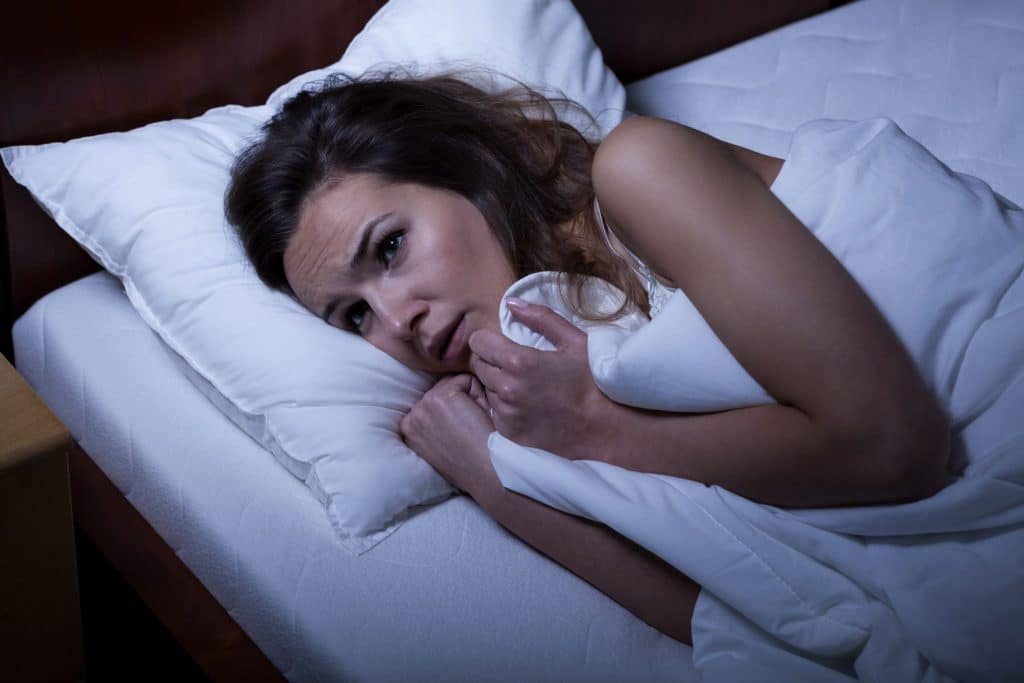
Short-term physical effects of stress can include difficulty swallowing, dizziness, dry mouth, nausea, fatigue, an increased heart rate, headaches, muscle aches and tension, lack of concentration, shortness of breath, sweating and hot flushes, trembling, nervous energy and insomnia. However, when these hormones and reactions continue to occur on a repeat basis, more long-term health problems can arise. These include a weakening of the immune system, digestive problems, short-term memory loss, premature coronary artery disease, and potentially even heart attacks. If ongoing anxiety is left untreated, it can lead to depression and suicidal feelings.
Yoga can be used as an effective tool to reduce and control stress through physical movement, breathing and meditation. Introducing a daily practice into your routine can help regulate your breath, relax your body, release muscle tension and circulate blood, oxygen and nutrients around the body, creating an overall sense of wellbeing.
Breathing Techniques

Breathing is one of the foundations of yoga, and along with Ujjayi, the technique that is used during a sequence of asanas in a yoga practice, there are a number of specific breathing (pranayama) exercises that can help calm the mind and minimize anxiety. By slowing the breath, you can slow down your heart rate and draw focus away from racing thoughts in the mind.
Learn these three yogic breathing exercises so that you can come back to them when you are feeling stressed or anxious.
Morning Practice (Surya Namaskar)
If anxiety or stress plagues your life on a regular basis, a short morning yoga practice can be a great way to start the day. All you need is 15 to 20 minutes, beginning with some meditative breathing for a couple of minutes followed by the joint release series and some sun salutations. The number of sun salutations you choose to do will depend on the amount of time you have and how much energy you have. You could do two, or you could do 10. A morning practice will revive and energize your body, clear your mind and start your day with positive energy.
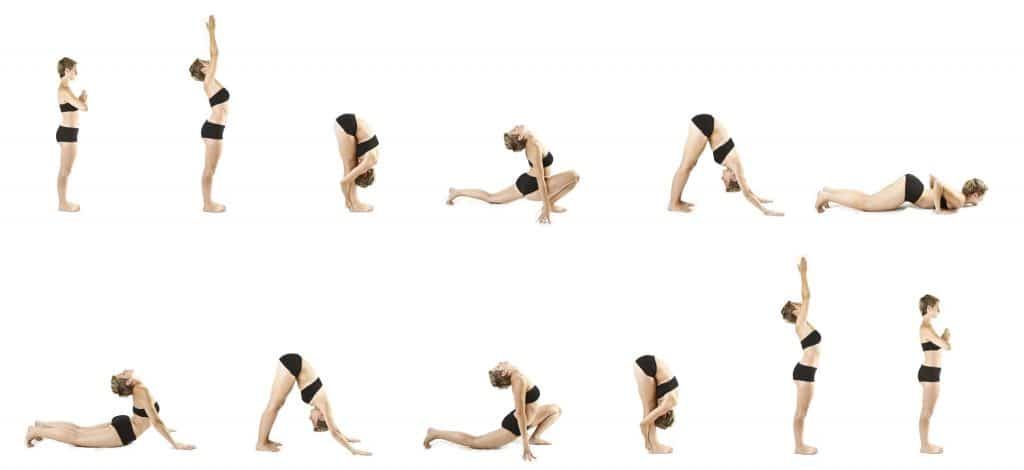
Try This Sequence Of Yoga Poses To Calm Anxiety
Certain yoga poses can induce different calming reactions in stressful situations. For example, seated poses, such as child’s pose and extended puppy pose, can help the mind reach a meditative state, while strong, heart opening poses like bow, triangle and pigeon can energize the body and make you feel more empowered about a situation. You can continue on with these poses after your sun salutations in the morning, or following a stressful day.
Bound Angle (Baddha Konasana)
This pose can be performed in three different ways – each of which will slightly change its benefits. For anxiety, one of the best options is reclined bound angle, where you are lying on your back with a block or blanket underneath your spine to open your chest. It is a restorative pose that rebalances the body and mind from the heart, which can help relieve feelings of anxiety.
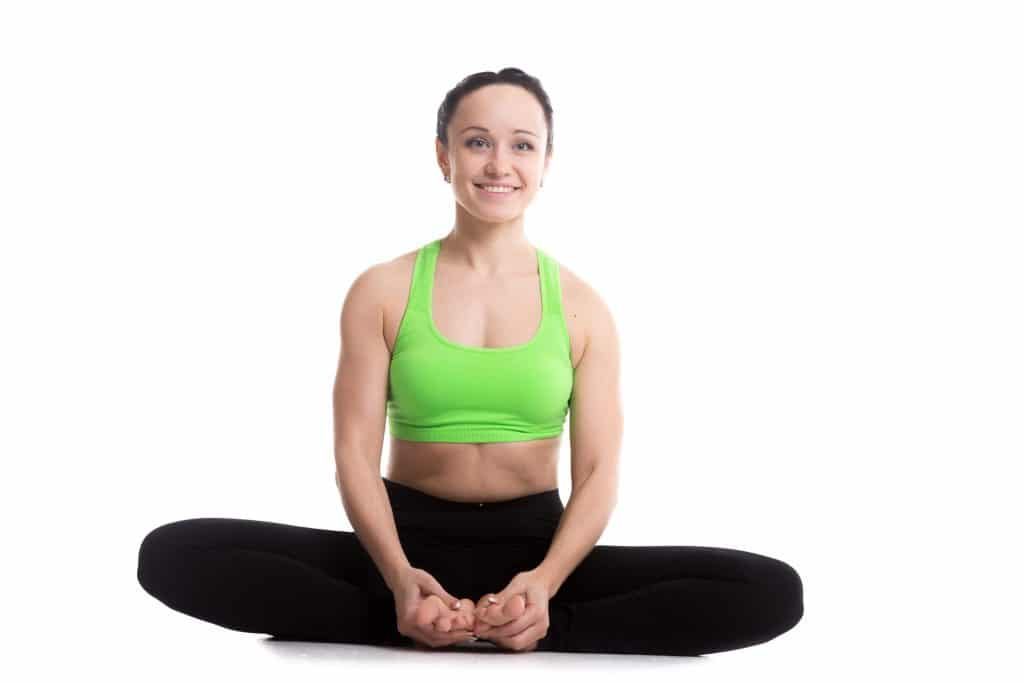
Start sitting up straight with your legs out in front of you, in staff pose. Fold your knees out to open your hips and place the soles of your feet together, bringing them as close to your groin as you can. Your legs should make a diamond shape. Take note of your back again and make sure it is nice and straight, not rounded. You can close your eyes and take long, slow yogic breaths in through the nose and out through the nose. From here, you can lean forward, and if you’re able to reach the ground beyond your feet, you can rest in that position, stretching out your back and hips.
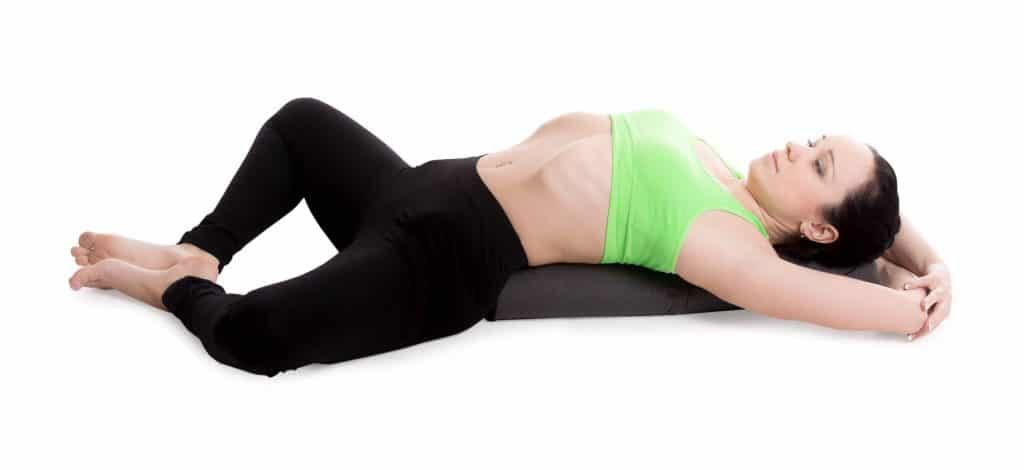
For reclined bound angle pose, or goddess pose, start by lying on your back with your knees bent. Slowly release your knees apart to the ground without straining the insides of your thighs or groin. Place the soles of your feet together, like you did in seated bound angle, and rest your hands either behind your head or out to the sides of your body, palms facing up. You can add a bolster or blanket underneath your spine to open your chest here. Relax in the pose and concentrate on long Ujjayi breaths.
Never force your knees to make them reach closer to the ground. It is important to let them fall gently to where they can naturally reach, and allow gravity to take care of the stretch for you.
Cat-Cow (Marjaryasana-Bitilasana)
This combination of two poses releases tension in the back, neck and pelvis and is quite meditative and relaxing as a short flow in a yoga sequence.
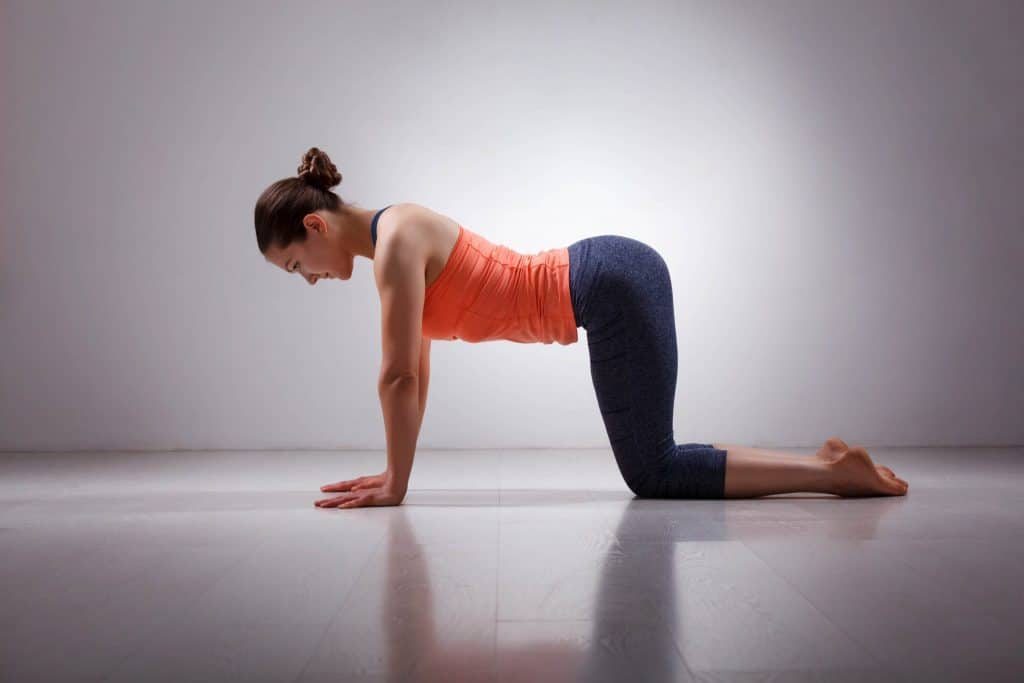
Start in tabletop position, with your hands and knees on the ground. Make sure your knees are directly below your hips and your wrists are directly in line with your elbows and shoulders, knees hip distance apart. As you inhale, arch your back and reach your tailbone and head towards the sky, and as you exhale, round your back so that your spine is curved towards the ceiling, dropping your head and tailbone towards the ground. Continue at your own pace with your breath for as many rounds as your body feels it needs. This could be anywhere between five and 20.
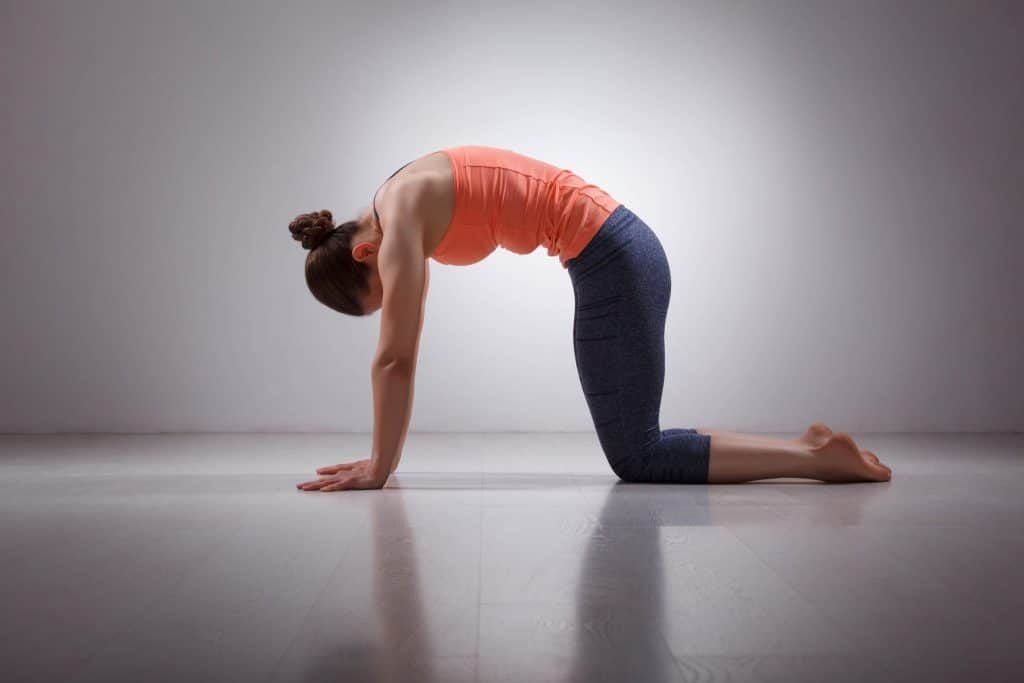
Child (Balasana)
This restful pose will ease the mind and evoke a feeling of relaxation. It is a soothing posture that gently stretches the back while calming stress and anxiety.
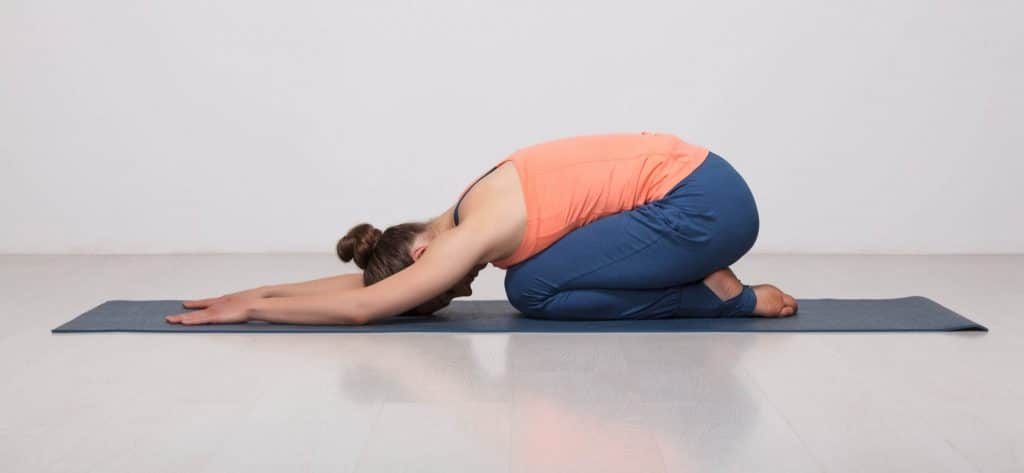
Start by kneeling on the floor with your knees hip distance apart from each other. The tops of your feet should be touching the floor, rather than the toes or balls of your feet. Take a long inhale and then, as you exhale, slowly lay your torso down on top of your thighs, stretching your arms out in front of you. Place the palms of your hands down and relax, allowing your hips and buttocks to rest as close to your feet and the ground as possible. Your forehead should be touching the ground and you can close your eyes for a few breaths, enjoying the calming pose.
Extended Puppy (Uttana Shishosana)
This back bend pose is a cross between child’s pose and downward facing dog, and it is quite therapeutic in its ability to calm the mind and stretch the body.

Start on your hands and knees with your shoulders above your wrists and hips above your knees then walk your hands forward, keeping your tailbone towards the ceiling, until you feel a stretch along your back. Keep your elbows just off the ground so that your arms remain active. There should be a slight curve in your lower back and you should feel a nice stretch along your spine and the front of your torso. Take some long breaths in the pose and imagine the oxygen moving all the way along your spine and torso into your lower abdomen on each inhale.
Bow (Dhanurasana)
This incredibly empowering pose strengthens the back and opens the chest. It will improve your posture over time, which, in turn, can improve self-esteem and breathing.
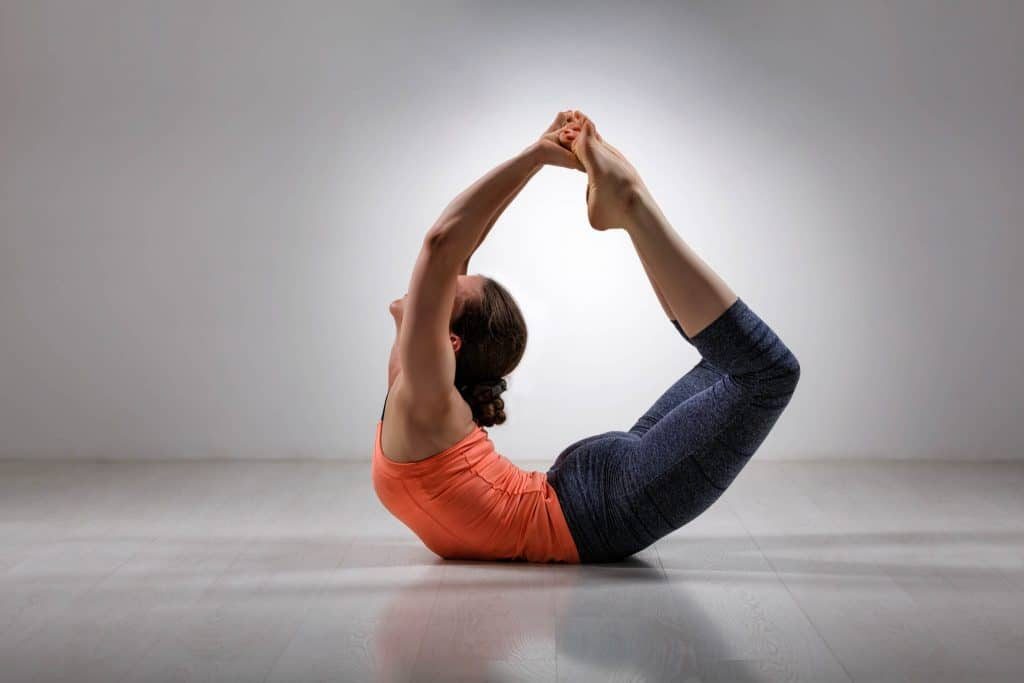
Start this pose by lying flat on your belly with your arms alongside your torso. Exhale all the breath out of your lungs that you can and bend your knees, reaching your heels towards your back. Take hold of your ankles and keep your knees hip distance apart (don’t let them drift outwards). As you inhale, lift your heels up towards the ceiling and your thighs away from the mat, which will pull up your chest and torso. You will feel tension in your back muscles and it can be quite a difficult pose if your back is weak or your thighs, pelvis and torso are tight. Once you are in the pose, remember to keep breathing (don’t hold your breath) and continue trying to lift more of your torso and thighs off the mat. Make sure your shoulders are away from your ears and pushed back slightly so that your chest is open. Keep your gaze towards the front so you don’t strain your neck. When you’re ready to release the pose, do so on an exhale and rest your forehead on your hands. After a few breaths, slide back into child’s pose to release and stretch your back.
Triangle (Trikonasana)
Not only does this pose decrease stress and ease anxiety, but it also stimulates the organs and improves metabolism and digestion, as well as stretching the spine, chest, shoulders, groin and hips. It also allows you to see the world from a different perspective – similar to inversions, where you stand upside down or on your head.
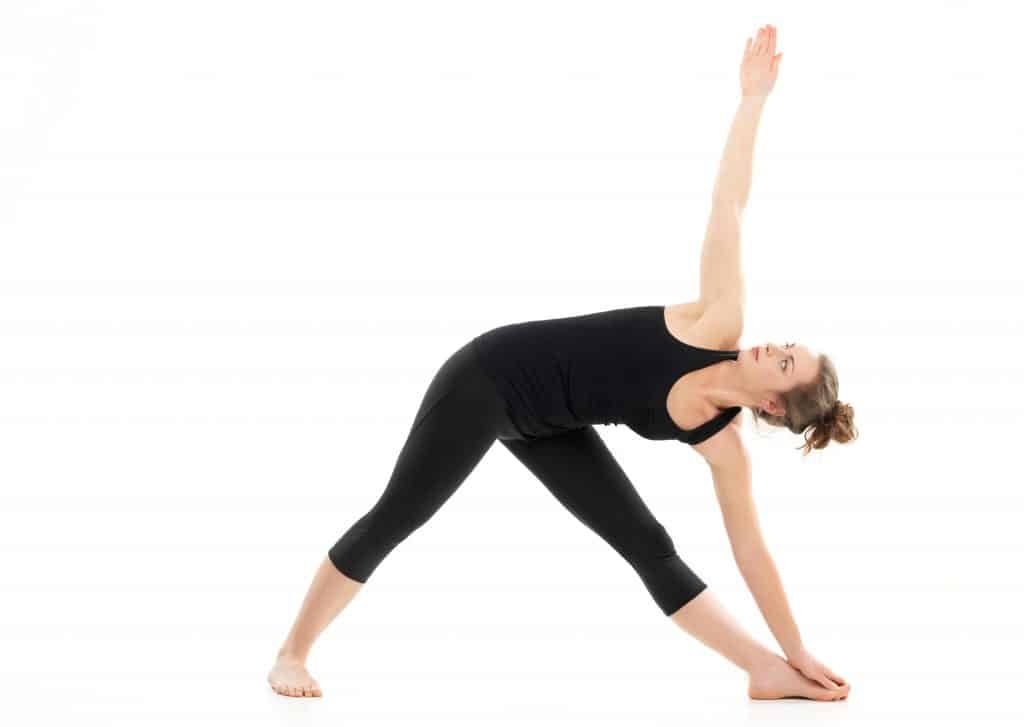
Stand with your legs wide (in a triangle shape) and point the toes of your front foot forward, with your back foot on a slight angle towards the outside of the mat. Line your front heel up with the middle of your back foot and make sure your hips and shoulders are directly above your legs, not twisting towards the front. Keep your legs straight and inhale, then, on the exhale, hinge your torso and upper body sideways towards the front of your mat. Keeping your torso stretched, bend your front arm towards your front foot and your back arm towards the ceiling. Keep your body in a straight line, as if you are squeezed in a gap between two walls. That means keeping your chest open and not allowing your body to tip forward. Only move your hand down as far as it can comfortably go without bending your knee or tipping your body. Rest your hand on your leg or in front of your ankle, if it will reach that far. Take a few breaths in this pose and then when you are ready to come back to a standing position, make sure your core is tight, which will protect your back, and lift up on an inhale. Turn your feet and repeat on the other side.
One-Legged Pigeon (Eka Pada Rajakapotasana)
This pose is perhaps the best thigh stretch and hip opening pose you will find. It melts away tension and anxiety, relieves sciatica and stimulates the abdominal organs, while improving muscle flexibility around the entire hip area.
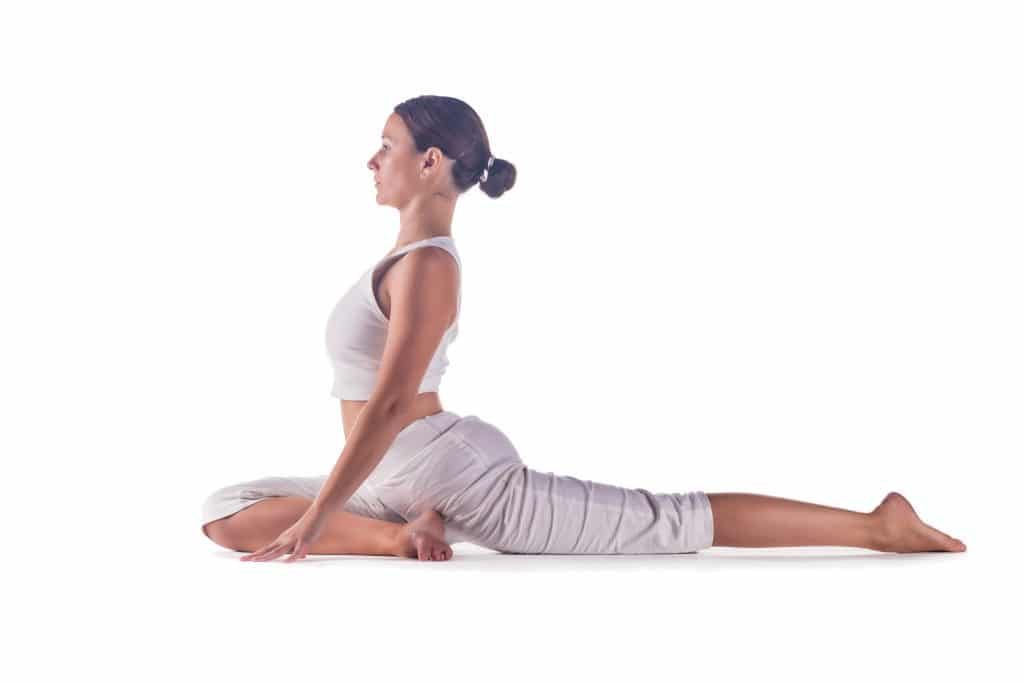
There are a few variations of pigeon, depending on your experience and flexibility. It is a very strong pose that stretches an extremely large muscle in your body, so you need to make sure you’re properly warmed up before moving into the posture, to avoid straining any muscles. If you are a beginner, have some folded blankets or cushions handy and start in downward facing dog. Gently bring one leg forward in between your hands, and set the outside of your leg down on the mat, with your lower leg crossing in front of your groin and opposite hip. Again, depending on your own flexibility, your leg might be on a bit of an angle back towards your groin. Never pick your leg up and force it to create more of an angle. As you exhale, start to move your other foot backwards, getting your groin and pelvis as close to the mat as possible. This is where you can add a blanket or cushion under your buttocks once you feel enough of a stretch. Take long breaths and imagine the air reaching your gluteus muscles on every inhale.

If you feel comfortable, you can lean your torso over your front leg and place your forearms on the ground. If you still feel as though you can stretch even deeper into the pose, you can lay your arms out in front of you and rest your forehead on the mat in front of your leg. Take some long breaths in this pose and try to relax into it.
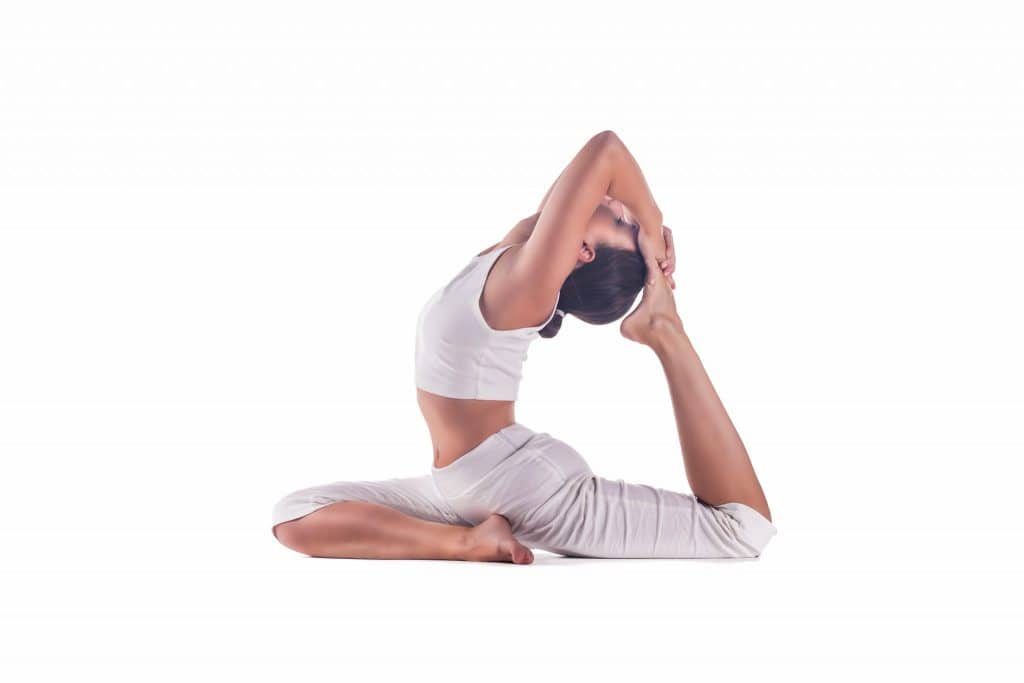
Slowly sit back up to your original position, and, only if you are comfortable in the pose, without the need for props such as blankets or cushions, you can try the next variation. Bend your back knee so that your foot is pointed upwards and twist your body from the torso, taking hold of your lifted ankle with the opposite hand. You should feel a stretch along the side of your body and down your quadriceps as well as your chest.
Boat (Navasana)
This is very much a core and back strengthening pose that also focuses on balance. It relieves anxiety as part of this overall stress-relieving sequence, by adding strength, focus and balance to your practice.
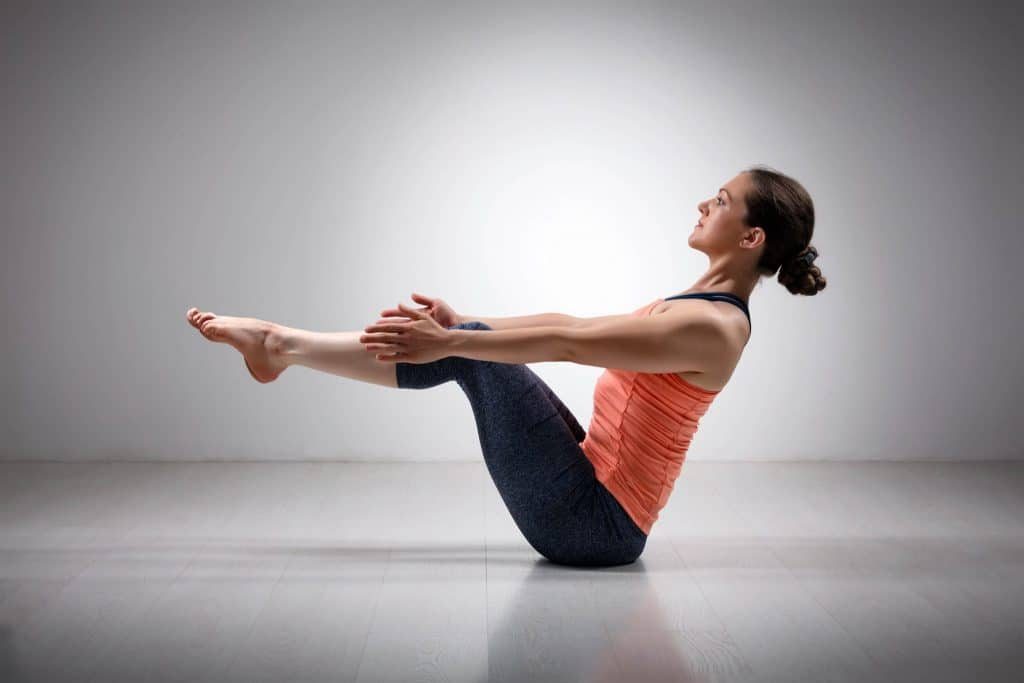
Start by sitting up straight on your mat with your legs out in front of you (staff pose), and then bend your knees and place your hands in the creases underneath. Tilt back slightly on your tailbone and slowly lift one leg and then the other so that they are pointed out in front of you. Make sure your back is straight and you are not hunched over. Think about opening your chest, shoulders back and down. When you feel balanced you can release your hands and shoot them out next to your legs. You should feel this posture all along your core. Don’t forget to breathe in boat pose! If you feel strong and balanced, you can straighten your legs so that your body is making a ‘V’ shape. Try to stay in this pose for a minute and you can repeat it as many times as you’d like.
Bridge (Setu Bandha Sarvangasana)
This gentle restorative pose is both a back bend and heart opener, and is also considered a minor inversion. This mix of opening the chest and heart cavity as well as changing the direction of blood flow calms anxiety and releases any stored emotions.
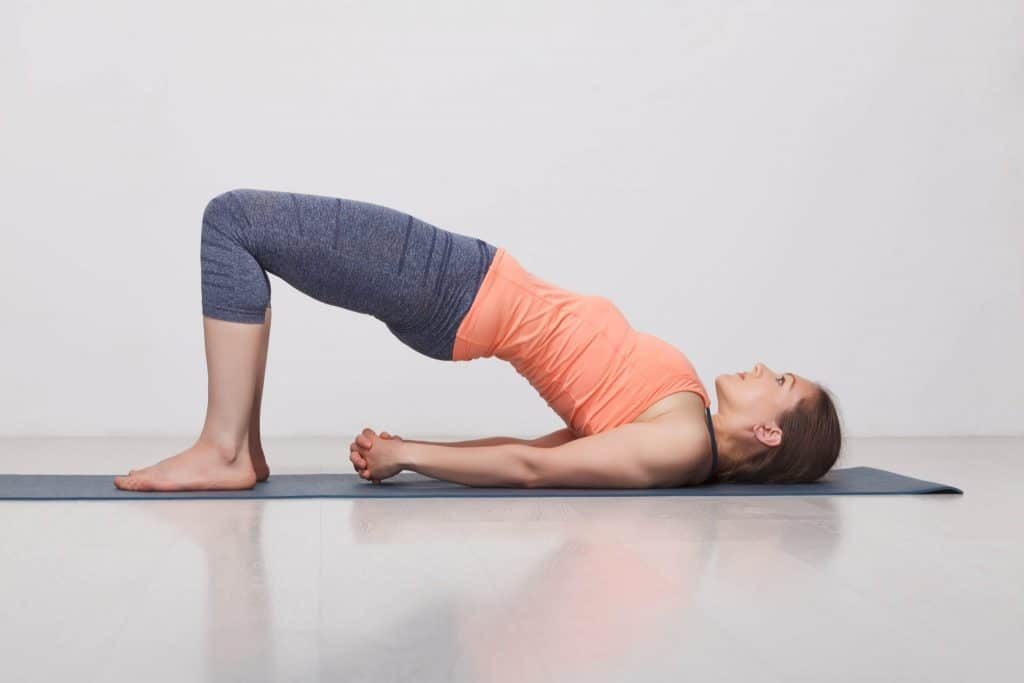
Lie on the floor with your knees bent and feet planted on the mat. Make sure your fingertips can brush your heels and your legs are hip distance apart. As you exhale, press your feet into the ground and slowly lift your tailbone, lower back, middle back and upper back towards the ceiling. Tuck your shoulders towards each other underneath your back and clasp your hands together below your buttocks. You should feel open across the chest and strong in the back. Take long, slow breaths in this pose and watch your belly expanding with each inhale and contracting with each exhale.
Restorative Poses
By this stage you will have already started a restorative sequence with bridge pose. But it is important to continue slowing the body back down and grounding after any yoga practice. A good pose to follow bridge with is a shoulder stand, which is an inversion suitable for beginners.
Start by lying on your mat with your knees bent and feet planted on the mat as close to your sitting bones as possible; arms alongside your torso. As you exhale, press your arms into the mat and push your feet upwards, drawing your thighs towards your mid-section. Lift your tailbone, lower back and middle back up off the mat and support your lower back with your hands, elbows planted on the mat. Try to keep your legs as straight as possible towards the ceiling and take some long breaths in this position. When you are ready to come back down, do so slowly, vertebrae by vertebrae touching the mat, rather than rolling back down.
Once you’re lying back down on the mat, you can move into a universal spinal twist. For this relaxing pose that stretches the spine, lift one knee up and relax it over the other leg towards the ground. Open your arms straight out in each direction, palms facing down and turn your gaze in the opposite direction of your bent knee. Relax in this pose for a few breaths and then slowly lay flat again and change legs.
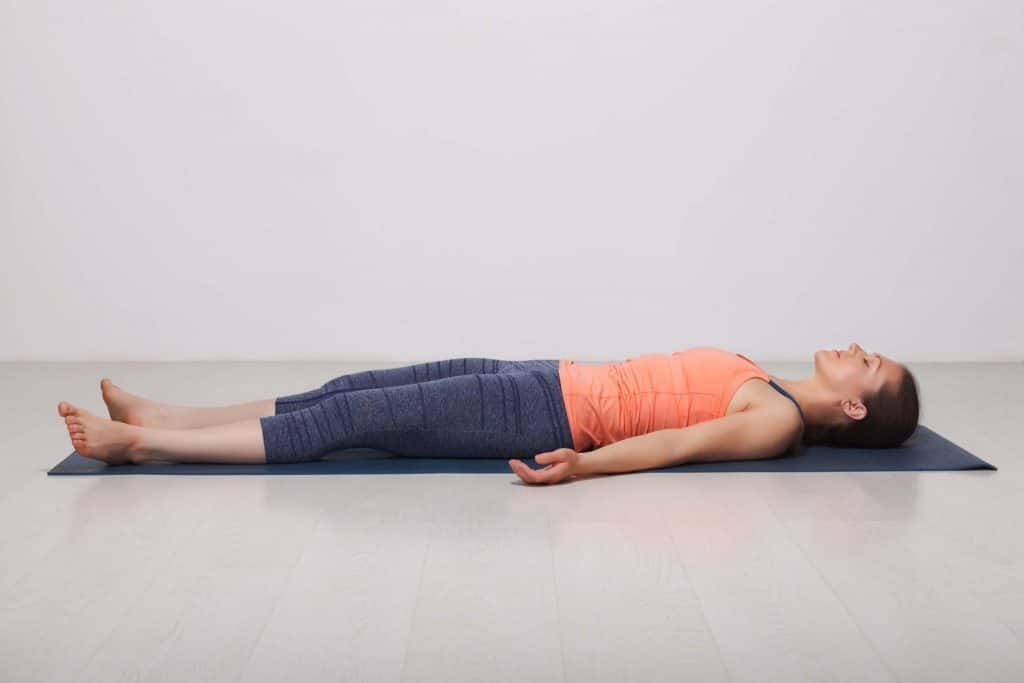
Lastly, relax in corpse pose, which is a meditative position that unwinds the whole body and the mind. Simply lay flat on your back and let your feet flop to either side and arms rest away from your body, palms facing up. Close your eyes and take long, slow yogic breaths in through your nose and out through your nose. You can play some relaxing music or guided meditation during your relaxation in corpse pose, which can also help ease anxiety and give you some tools to use when you find yourself in a stressful situation.
If you suffer from anxiety or depression, you should seek help from a professional. Yoga and meditation are fantastic tools to introduce into your everyday life for overall wellness, both in the body and the mind. It can help you deal with mild stress and anxiety, as well as complement professional counselling or treatment for severe anxiety or depression.



